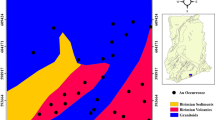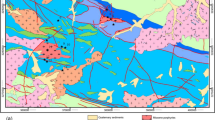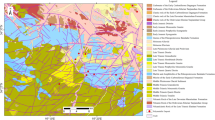Abstract
Mineral prospectivity map** is an important preliminary step for mineral resource exploration. It has been widely applied to distinguish areas of high potential to host mineral deposits and to minimize the financial risks associated with decision making in mineral industry. In the present study, a maximum entropy (MaxEnt) model was applied to investigate its potential for mineral prospectivity analysis. A case study from the Nanling tungsten polymetallic metallogenic belt, South China, was used to evaluate its performance. In order to deal with model over-fitting, varying levels of β j -regularization were set to determine suitable β value based on response curves and receiver operating characteristic (ROC) curves, as well as via visual inspections of prospectivity maps. The area under the ROC curve (AUC = 0.863) suggests good performance of the MaxEnt model under the condition of balancing model complexity and generality. The relative importance of ore-controlling factors and their relationships with known deposits were examined by jackknife analysis and response curves. Prediction–area (P–A) curves were used to determine threshold values for demarcating high probability of tungsten polymetallic deposit occurrence within small exploration area. The final predictive map showed that high favorability zones occupy 14.5% of the study area and contain 85.5% of the known tungsten polymetallic deposits. Our study suggests that the MaxEnt model can be efficiently used to integrate multisource geo-spatial information for mineral prospectivity analysis.








Similar content being viewed by others
References
Abedi, M., Norouzi, G. H., & Bahroudi, A. (2012). Support vector machine for multi-classification of mineral prospectivity areas. Computers & Geosciences, 46, 272–283.
Abedi, M., Norouzi, G. H., & Fathianpour, N. (2013). Fuzzy outranking approach: A knowledge-driven method for mineral prospectivity map**. International Journal of Applied Earth Observation and Geoinformation, 21, 556–567.
Agterberg, F. P. (1992). Combining indicator patterns in weights of evidence modeling for resource evaluation. Natural Resources Research, 1(1), 39–50.
Agterberg, F. P., Bonham-Carter, G. F., & Wright, D. F. (1990). Statistical pattern integration for mineral exploration. Computer Applications in Resource Estimation: Predictions and Assessment for Metals and Petroleum, 63, 1–21.
Anderson, R. P., & Gonzalez, I. (2011). Species-specific tuning increases robustness to sampling bias in models of species distributions: an implementation with Maxent. Ecological Modelling, 222(15), 2796–2811.
Bonham-Carter, G. F. (1994). Geographic information systems for geoscientists, modelling with GIS. New York: Pergamon.
Bonham-Carter, G. F., Agterberg, F. P., & Wright, D. F. (1989). Weights of evidence modelling: A new approach to map** mineral potential. Statistical Applications in the Earth Sciences, 89(9), 171–183.
Carranza, E. J. M. (2010). Improved wildcat modelling of mineral prospectivity. Resource Geology, 60, 129–149.
Carranza, E. J. M. (2017). Natural resources research publications on geochemical anomaly and mineral potential map**, and introduction to the special issue of papers in these fields. Natural Resources Research, 26(4), 379–410.
Carranza, E. J. M., & Hale, M. (2001). Logistic regression for geologically constrained map** of gold potential, Baguio district, Philippines. Exploration and Mining Geology, 10(3), 165–175.
Carranza, E. J. M., & Hale, M. (2003). Evidential belief functions for data-driven geologically constrained map** of gold potential, Baguio district, Philippines. Ore Geology Reviews, 22(1), 117–132.
Carranza, E. J. M., & Laborte, A. G. (2015). Data-driven predictive map** of gold prospectivity, Baguio district, Philippines: Application of Random Forests algorithm. Ore Geology Reviews, 71, 777–787.
Chen, Y. (2015). Mineral potential map** with a restricted Boltzmann machine. Ore Geology Reviews, 71, 749–760.
Chen, Y., Lu, L., & Li, X. (2014). Application of continuous restricted Boltzmann machine to identify multivariate geochemical anomaly. Journal of Geochemical Exploration, 140, 56–63.
Chen, Y., Pei, R., & Zhang, H. (1990). Mineral deposit of nonferrous metal and rare metal associated with Mesozoic granite in the Nanling region. Bulletin of the Chinese Academy of Geological Science, 20, 79–85. (in Chinese).
Chen, Y., & Wu, W. (2016). A prospecting cost-benefit strategy for mineral potential map** based on ROC curve analysis. Ore Geology Reviews, 74, 26–38.
Elith, J., Graham, C. H., Anderson, R. P., Dudík, M., Ferrier, S., Guisan, A., et al. (2006). Novel methods improve prediction of species’ distributions from occurrence data. Ecography, 29, 129–151.
Elith, J., Phillips, S. J., Hastie, T., Dudík, M., Chee, Y. E., & Yates, C. J. (2011). A statistical explanation of MaxEnt for ecologists. Diversity and Distributions, 17(1), 43–57.
Fallon, M., Porwal, A., & Guj, P. (2010). Prospectivity analysis of the Plutonic Marymia Greenstone Belt, Western Australia. Ore Geology Reviews, 38(3), 208–218.
He, B., Chen, C., & Liu, Y. (2010). Mineral potential map** for Cu–Pb–Zn deposits in the East Kunlun Region, Qinghai Province, China, integrating multi-source geology spatial data sets and extended weights-of-evidence modeling. GIScience & Remote Sensing, 47(4), 514–540.
Hernandez, P. A., Graham, C. H., Master, L. L., & Albert, D. L. (2006). The effect of sample size and species characteristics on performance of different species distribution modeling methods. Ecography, 29, 773–785.
Hronsky, J. M. A., & Groves, D. I. (2008). Science of targeting: Definition, strategies, targeting and performance measurement. Australian Journal of Earth Sciences, 55(1), 3–12.
Hu, R., & Zhou, M. (2012). Multiple Mesozoic mineralization events in South China—An introduction to the thematic issue. Mineralium Deposita, 47, 579–588.
Hua, R., Chen, P., Zhang, W., & Lu, J. (2005). Three major metallogenic events in Mesozoic in South China. Mineral Deposits, 24(2), 99–107. (in Chinese with English abstract).
Hua, R., Li, G., Zhang, W., Hu, D., Chen, P., Chen, W., et al. (2010). A tentative discussion on differences between large-scale tungsten and tin mineralizations in South China. Mineral Deposits, 29(1), 9–23. (in Chinese with English abstract).
Hua, R., Zhang, W., Li, G., Hu, D., & Wang, X. (2008). A preliminary study on the features and geologic implication of the accompanying metals in tungsten deposits in the Nanling region. Geological Journal of China Universities, 14(4), 527–538. (in Chinese with English abstract).
Jaynes, E. T. (1957). Information theory and statistical mechanics. Physical Review, 106(4), 620–630.
Joly, A., Porwal, A., & McCuaig, T. C. (2012). Exploration targeting for orogenic gold deposits in the Granites-Tanami Orogen: Mineral system analysis, targeting model and prospectivity analysis. Ore Geology Reviews, 48, 349–383.
Li, B. (2011). Synchronization theory and tungsten-polymetallic mineralization distribution in the Qianlishan-Qitianling area, South Hunan. Journal of Earth Science, 22, 726–736.
Liu, Y., Cheng, Q., **a, Q., & Wang, X. (2013). Application of singularity analysis for mineral potential identification using geochemical data—A case study: Nanling W–Sn–Mo polymetallic metallogenic belt, South China. Journal of Geochemical Exploration, 134, 61–72.
Liu, Y., Cheng, Q., ** for tungsten polymetallic deposits in the Nanling metallogenic belt, South China. Journal of Earth Science, 25(4), 689–700.
Liu, Y., Cheng, Q., **a, Q., & Wang, X. (2014b). Multivariate analysis of stream sediment data from Nanling metallogenic belt, South China. Geochemistry: Exploration, Environment, Analysis, 14(4), 331–340.
Liu, Y., Cheng, Q., ** in the Nanling belt, South China. Frontiers of Earth Science, 9(2), 342–354.
Liu, Y., Cheng, Q., Zhou, K., **a, Q., & Wang, X. (2016). Multivariate analysis for geochemical process identification using stream sediment geochemical data: A perspective from compositional data. Geochemical Journal, 50(4), 293–314.
Liu, Y., Zhou, K., & Cheng, Q. (2017a). A new method for geochemical anomaly separation based on the distribution patterns of singularity indices. Computers & Geosciences, 105, 139–147.
Liu, Y., Zhou, K., Zhang, N., & Wang, J. (2017b). Maximum entropy modeling for orogenic gold prospectivity map** in the Tangbale-Hatu belt, western Junggar, China. Ore Geology Reviews. doi:10.1016/j.oregeorev.2017.04.029.
Lu, H., Liu, Y., Wang, C., Xu, Y., & Li, H. (2003). Mineralization and fluid inclusion study of the Shizhuyuan W–Sn–Bi–Mo–F skarn deposit, Hunan Province, China. Economic Geology, 98(5), 955–974.
Mao, J., **e, G., Guo, C., & Chen, Y. (2007). Large-scale tungsten–tin mineralization in the Nanling region South China: Metallogenic ages and corresponding geodynamic processes. Acta Petrologica Sinica, 23(10), 2329–2338. (in Chinese with English abstract).
McCuaig, T. C., Beresford, S., & Hronsky, J. M. A. (2010). Translating the mineral systems approach into an effective exploration targeting system. Ore Geology Reviews, 38(3), 128–138.
Muscarella, R., Galante, P., Soley-Guardia, M., Boria, R. A., Kass, J. M., Uriarte, M., et al. (2014). ENMeval: An R package for conducting spatially independent evaluations and estimating optimal model complexity for Maxent ecological niche models. Methods in Ecology and Evolution, 5(11), 1198–1205.
Nykänen, V., Lahti, I., Niiranen, T., & Korhonen, K. (2015). Receiver operating characteristics (ROC) as validation tool for prospectivity models—A magmatic Ni–Cu case study from the Central Lapland Greenstone Belt, Northern Finland. Ore Geology Reviews, 71, 853–860.
Nykänen, V., Niiranen, T., Molnár, F., Lahti, I., Korhonen, K., Cook, N., et al. (2017). Optimizing a knowledge-driven prospectivity model for gold deposits within Peräpohja Belt, Northern Finland. Natural Resources Research, 26(4), 1–14.
Oh, H. J., & Lee, S. (2010). Application of artificial neural network for gold–silver deposits potential map**: A case study of Korea. Natural Resources Research, 19(2), 103–124.
Pearson, R. G., Raxworthy, C. J., Nakamura, M., & Townsend Peterson, A. (2007). Predicting species distributions from small numbers of occurrence records: a test case using cryptic geckos in Madagascar. Journal of Biogeography, 34(1), 102–117.
Pei, R., Wang, Y., & Wang, H. (2009). Ore-forming specialty of the tectono-magmatic zone in Nanling region and its emplacement dynamics for metallogenic series of W–Sn polymetallic deposits. Geology in China, 36(3), 483–489. (in Chinese with English Abstract).
Peterson, A. T., Papes, M., & Eaton, M. (2007). Transferability and model evaluation in ecological niche modeling: A comparison of GARP and Maxent. Ecography, 30, 550–560.
Phillips, S. J. (2005). A brief tutorial on Maxent. AT&T Research.
Phillips, S. J., Anderson, R. P., Dudík, M., Schapire, R. E., & Blair, M. E. (2017). Opening the black box: An open-source release of Maxent. Ecography, 40, 887–893.
Phillips, S. J., Anderson, R. P., & Schapire, R. E. (2006). Maximum entropy modeling of species geographic distributions. Ecological Modelling, 190(3), 231–259.
Phillips, S. J., & Dudík, M. (2008). Modeling of species distributions with Maxent: New extensions and a comprehensive evaluation. Ecography, 31(2), 161–175.
Phillips, S. J., Dudík, M., & Schapire, R. E. (2004). A maximum entropy approach to species distribution modeling. In Proceedings of the twenty-first international conference on Machine learning (p. 83). ACM.
Phillips, S. J., Dudík, M., & Schapire, R. E. (2007). Maxent software for species habitat modeling. http://rob.schapire.net.
Porwal, A., Carranza, E. J. M., & Hale, M. (2003). Artificial neural networks for mineral-potential map**: A case study from Aravalli Province, Western India. Natural resources research, 12(3), 155–171.
Rodriguez-Galiano, V. F., Chica-Olmo, M., & Chica-Rivas, M. (2014). Predictive modelling of gold potential with the integration of multisource information based on random forest: A case study on the Rodalquilar area, South Spain. International Journal of Geographical Information Science, 28(7), 1336–1354.
Rodriguez-Galiano, V., Sanchez-Castillo, M., Chica-Olmo, M., & Chica-Rivas, M. (2015). Machine learning predictive models for mineral prospectivity: An evaluation of neural networks, random forest, regression trees and support vector machines. Ore Geology Reviews, 71, 804–818.
Shu, L., Deng, P., Wang, B., Yu, X., & Sun, Y. (2004). Lithological, Kinematic and Geochronological constraints on the Late Mesozoic Basin—Mountain Evolution in the Zhuguang—Nanxiong Area, South China. Science in China (D), 47(8), 673–688. (in Chinese with English abstract).
Wisz, M. S., Hijmans, R. J., Li, J., Peterson, A. T., Graham, C. H., & Guisan, A. (2008). Effects of sample size on the performance of species distribution models. Diversity and Distributions, 14(5), 763–773.
Yin, J., Kim, S. J., Lee, H. K., & Itay, T. (2002). K–Ar ages of plutonism and mineralization at the Shizhuyuan W–Sn–Bi–Mo deposit, Hunan Province, China. Journal of Asian Earth Sciences, 20(2), 151–155.
Yousefi, M., & Carranza, E. J. M. (2015a). Prediction–area (P–A) plot and C-A fractal analysis to classify and evaluate evidential maps for mineral prospectivity modeling. Computers & Geosciences, 79, 69–81.
Yousefi, M., & Carranza, E. J. M. (2015b). Geometric average of spatial evidence data layers: a GIS-based multi-criteria decision-making approach to mineral prospectivity map**. Computers & Geosciences, 83, 72–79.
Yousefi, M., & Carranza, E. J. M. (2016). Data-driven index overlay and Boolean logic mineral prospectivity modeling in greenfields exploration. Natural Resources Research, 25(1), 3–18.
Zuo, R., & Carranza, E. J. M. (2011). Support vector machine: A tool for map** mineral prospectivity. Computers & Geosciences, 37(12), 1967–1975.
Acknowledgments
We would like to thank Editor-in-Chief Dr. John Carranza and two anonymous reviewers who provided valuable comments that have helped us to greatly improve the quality of the paper. This work was jointly funded by the Natural Science Foundation of China (Nos. 41672328, U1503291) and the CAS “Light of West China” program (2015-XBQN-B-23).
Author information
Authors and Affiliations
Corresponding author
Rights and permissions
About this article
Cite this article
Liu, Y., Zhou, K. & **. Nat Resour Res 27, 299–313 (2018). https://doi.org/10.1007/s11053-017-9355-2
Received:
Accepted:
Published:
Issue Date:
DOI: https://doi.org/10.1007/s11053-017-9355-2




